Extraction Method and Integration Framework for Perception Features of Public Opinion in Transportation
Abstract
1. Introduction
- The evolutional features of transportation public opinion are more obvious. Transportation incidents directly affect the benefits of travelers. As a characteristic of transportation, Mobility as a Service (MaaS) extended its relationship with the national economy and people’s livelihood. Besides, the change of public opinion is closely related to the evolution of traffic incidents and the performance of disposal. Hence, negative public opinion could put great pressure on industry management, if handled improperly [14].
- The incident-cause factors of transportation are more complicated. Since the occurrence of incidents may involve many factors including infrastructure construction, operation management, passengers’ service, and surrounding circumstance. On top of that, the subjective factors are usually mixed with objective factors, and it is hard to distinguish them [15].
2. Literature Review
- The establishment of public opinion perception features system for transportation management is still developing.
- Existing approaches mainly focus on thematic features and emotional features, with very limited attention to spatiotemporal features and evolutional features.
- A majority of existing applications focus on partial perception features, normally overlooking the value of the integrated features system.
- Social media is increasingly being applied in special traffic events, while other applications, aiming at general traffic incidents based on their sources and fundamental characteristics, are frequently ignored in current research.
- Based on the public opinion life cycle, we establish the transportation public opinion perception features system, devoted to traffic monitoring and decision-making. We set up four primary-aspect features, like thematic feature and spatiotemporal feature, and eleven secondary-aspect features such as time and location.
- Exploring extraction methods of public opinion perception features. Establishing a set of perceptual feature extraction methods and an integrated application framework suitable for transportation public opinion. This integrated application framework focuses on improving the spatiotemporal feature analysis method and evolutional feature modeling ideas.
- Using Shenzhen bus as the case, mining the relationship between satisfaction and bus service index, clarifying the specific content of people’s satisfaction and dissatisfaction, and proving the feasibility and reliability of this method.
3. Method: Construction and Extraction Methodology of Perception Features System
3.1. Perception Features System of Public Opinion in Transportation
- Thematic features: Only when the thematic feature of transportation public opinion is identified, can the involved type of transportation problems be classified properly. Besides, transportation public opinion is normally caused by traffic incidents, so it is critical to classify traffic incidents. By analyzing key traffic events in recent years, it is found that involved incidents mainly include traffic accidents, traffic congestion caused by meteorological disasters and road maintenance, traffic control, and shared transport. Combined with the classification of traffic incidents and the topic of public concern, features can be clearly defined.
- Spatiotemporal features: The occurrence of traffic accidents and traffic congestion takes on strong characteristics of time and space; meanwhile, traffic control and shared transport have strong spatial geographical characteristics. Hence, it is scientific and practical to determine spatiotemporal features, which are helpful in analyzing the specific time and space of traffic incidents and in guiding transportation public opinion from the source.
- Emotional features: To judge people’s attitudes toward specific traffic events efficiently, emotional features are developed, which are helpful for administrators to grasp public opinion accurately and make reasonable decisions. What’s more, the effectiveness of decisions can be evaluated by comparing emotional status before and after implementations.
- Evolutional features: To monitor the dynamic development trend of traffic incidents and take corresponding measures reasonably, evolutional features are built, based on the lifecycle of public opinion from the occurrence to development to extinction. As for positive trends, managers should continue to consolidate relevant measures, and corresponding early warnings should be made promptly to prevent negative trends.
3.2. Extraction Method of Perception Features
3.2.1. Thematic Features
3.2.2. Spatiotemporal Features
- From the first word, compare them with the words in the database of pattern N. If there exists the same word, it will be judged as N mode, and the word will be taken out as a time feature of the text until all words are tested.
- From the first word, judge whether the word is a numeral and if so, continue to judge the unit next to the numeral. Case 1: If it is a noun, compare it with the temporal noun database. Following this, if the same word is found, it is identified as the pattern of Num + N, and it is taken out as the time feature of the text. Case 2: If there is a symbol “:”, “.” or “/”, it will then continue to be tested whether the unit next to the word is a numeral. If so, it will be recognized as a pattern of Num: Num, Num. Num, or Num/ Num, which is taken out as the time feature of the text until all the words are tested.
3.2.3. Emotional Features
3.2.4. Evolutional Features
3.3. Integrated Framework for Perception Features
4. Case Analysis
4.1. Public Opinion Data Collection and Preprocessing in Shenzhen
4.2. Features Extraction and Integrated Application
4.2.1. Extraction and Analysis of Emotional Features
- The trend between passengers’ satisfaction and bus service index in 2016 is consistent. In the second quarter of 2016, the satisfaction and service index decreased compared with the first quarter and then showed an upward trend in the third and fourth quarters. It illustrates that satisfaction obtained by this method is reasonable since there is the same fluctuation trend between them.
- In the first quarter of 2017, passengers’ satisfaction and bus service index showed an opposite trend. At that time, the bus service index showed an upward trend, while satisfaction showed a downward trend. Indicators examined by Shenzhen bus service index include the degree of congestion, waiting time of passengers, the travel speed of passengers, maintenance of station facilities, etc. It indicated that there may be some non-mentioned index factors, such as policies, management measures, or special events, which lead to satisfaction decline. Specific reasons are thought of in the following section.
4.2.2. Extraction and Analysis of Evolutional Features
4.2.3. Extraction and Analysis of Spatial Features
4.2.4. Detail Evaluation of Shenzhen Bus
5. Conclusions
Author Contributions
Funding
Institutional Review Board Statement
Informed Consent Statement
Data Availability Statement
Conflicts of Interest
References
- Emilia, S.; Enora, R.; Jenny, M. Night-Time Mobilities and Justice in London: Constructing Mobile Subjects and the Politics of Difference in Policy-Making. J. Transp. Geogr. 2020, 82, 102569. [Google Scholar]
- Cristina, M.; Campos, A.; Diego, P.; Gemma, P.; Jose, L. Long-Term Cost Efficiency of Alternative Management Forms for Urban Public Transport from the Public Sector Perspective. Transp. Policy 2020, 88, 16–23. [Google Scholar]
- Aseem, K.; Samaneh, B.; Rasmus, B.; Thomas, A.; Francisco, P. Examining the Potential of Textual Big Data Analytics for Public Policy Decision-Making: A Case Study with Driverless Cars in Denmark. Transp. Policy 2020, 98, 68–78. [Google Scholar]
- Behbahani, H.; Nazari, S.; Kang, M.; Litman, T. A Conceptual Framework to Formulate Transportation Network Design Problem Considering Social Equity Criteria. Transp. Res. Pt. A-Policy Pract. 2019, 125, 171–183. [Google Scholar] [CrossRef]
- Enoch, M.; Cross, R.; Potter, N.; Davidson, C.; Taylor, S. Future Local Passenger Transport System Scenarios and Implications for Policy and Practice. Transp. Policy 2020, 90, 52–67. [Google Scholar] [CrossRef]
- Peters, L.; MacKenzie, D. The Death and Rebirth of Bikesharing in Seattle: Implications for Policy and System Design. Transp. Res. Pt. A-Policy Pract. 2019, 130, 208–226. [Google Scholar] [CrossRef]
- Cunningham, M.; Regan, M.; Horberry, T.; Weeratunga, K.; Dixit, V. Public Opinion about Automated Vehicles in Australia: Results from a Large-Scale National Survey. Transp. Res. Pt. A-Policy Pract. 2019, 129, 1–18. [Google Scholar] [CrossRef]
- Li, S.; Zhao, P.; Zhang, H.; Quan, J. Walking Behavior in the Old Downtown Beijing: The Impact of Perceptions and Attitudes and Social Variations. Transp. Policy 2018, 73, 1–11. [Google Scholar] [CrossRef]
- Kauffmann, E.; Peral, J.; Gil, D.; Ferrandez, A.; Sellers, R.; Mora, H. Managing Marketing Decision-Making with Sentiment Analysis: An Evaluation of the Main Product Features Using Text Data Mining. Sustainability 2019, 11, 15. [Google Scholar] [CrossRef]
- Anik, M.; Sadeek, S.; Hossain, M.; Kabir, S. A Framework for Involving the Young Generation in Transportation Planning Using Social Media and Crowd Sourcing. Transp. Policy 2020, 97, 1–18. [Google Scholar] [CrossRef]
- Ballestar, M.; Cuerdo-Mir, M.; Freire-Rubio, M. The Concept of Sustainability on Social Media: A Social Listening Approach. Sustainability 2020, 12, 2122. [Google Scholar] [CrossRef]
- Xu, J.; Tang, W.; Zhang, Y.; Wang, F. A Dynamic Dissemination Model for Recurring Online Public Opinion. Nonlinear Dyn. 2020, 99, 1269–1293. [Google Scholar] [CrossRef]
- Murry, M.W.E.; Isaacowitz, D.M. Age Differences in Emotion Perception: The Effects of the Social Environment. Int. J. Behav. Dev. 2017, 41, 597–604. [Google Scholar] [CrossRef]
- Sigal, K.; Shaun, B.D.; Carlo, P. The Relation Between the Perception of Safe Traffic and the Comprehension of Road Signs in Conditions of Ambiguous and Redundant Information. Transp. Res. Pt. F-Traffic Psychol. Behav. 2018, 55, 415–425. [Google Scholar]
- Smith, G.; Sochor, J.; Karlsson, I.C.M. Mobility as a Service: Development Scenarios and Implications for Public Transport. Res. Transp. Econ. 2018, 69, 592–599. [Google Scholar] [CrossRef]
- Jonghak, L.; Junghyo, C.; Taekwan, Y.; Hojin, Y. Traffic Accident Severity Analysis with Rain-Related Factors Using Structural Equation Modeling-A Case Study of Seoul City. Accid. Anal. Prev. 2018, 112, 1–10. [Google Scholar]
- Li, R.; Pereira, F.C.; Akiva, M.E. Overview of Traffic Incident Duration Analysis and Prediction. Eur. Transp. Res. Rev. 2018, 10, 1–13. [Google Scholar] [CrossRef]
- Nima, H.N.; Liu, X.; Ran, W.; Liu, W.; Hu, S. Using Twitter Data for Transit Performance Assessment: A Framework for Evaluating Transit Riders’ Opinions about the Quality of Service. Pub. Transp. 2018, 10, 363–377. [Google Scholar]
- Farman, A.; Daehan, K.; Pervez, K.; Shaker, E.; Amjad, A.; Ssna, U.; Hyum, K.; Kyung, K. Transportation Sentiment Analysis Using a Word Embedding and Ontology-Based Topic Modeling. Knowl. Based Syst. 2019, 174, 27–42. [Google Scholar]
- Farman, A.; Daehan, K.; Pervez, K.; Riazul, I.M.; Hyun, K.K.; Kwak, K.S. Fuzzy Ontology-Based Sentiment Analysis of Transportation and City Feature Reviews for Safe Traveling. Transp. Res. Pt. C-Emerg. Technol. 2017, 77, 33–48. [Google Scholar]
- Chakraborty, P.; Sharma, A. Public Opinion Analysis of the Transportation Policy Using Social Media Data: A Case Study on the Delhi Odd-Even Policy. Transp. Dev. Econ. 2019, 5, 5.1–5.9. [Google Scholar] [CrossRef]
- Zhang, Z.; Qing, H.; Jing, G.; Ming, N. A Deep Learning Approach for Detecting Traffic Accidents from Social Media Data. Transp. Res. Pt. C-Emerg. Technol. 2017, 86, 580–596. [Google Scholar] [CrossRef]
- Li, D.; Zhang, Y.; Cheng, C. Mining Public Opinion on Transportation Systems Based on Social Media Data. Sustainability 2019, 11, 4016. [Google Scholar] [CrossRef]
- Ahmed, M.F.; Vanajakshi, L.; Suriyanarayanan, R. Real-Time Traffic Congestion Information from Tweets Using Supervised and Unsupervised Machine Learning Techniques. Transp. Dev. Econ. 2019, 5, 1–11. [Google Scholar] [CrossRef]
- Gu, Y.; Lu, W.; Xu, X.; Qin, L.; Zhang, H. An Improved Bayesian Combination Model for Short-Term Traffic Prediction with Deep Learning. IEEE Trans. Intell. Transp. Syst. 2020, 21, 1524–9050. [Google Scholar] [CrossRef]
- Sinnott, R.; Yin, S. Accident Black Spot Identification and Verification through Social Media. In Proceedings of the IEEE International Conference on Data Science and Data Intensive Systems, Sydney, NSW, Australia, 11–13 December 2015; pp. 17–24. [Google Scholar]
- Mahmud, H.; Mehmet, O.; Rolf, S. A Survey on Real-Time Event Detection from the Twitter Data Stream. J. Inf. Sci. 2017, 44, 443–463. [Google Scholar]
- Lu, H.; Shi, K.; Zhu, Y.; Yi, L.; Niu, Z. Sensing Urban Transportation Events from Multi-Channel Social Signals with the Word2vec Fusion Model. Sensors 2018, 18, 4093. [Google Scholar] [CrossRef]
- Cao, D.L.; Wang, S.R.; Lin, D.Z. Chinese Microblog Users’ Sentiment-Based Traffic Condition Analysis. Soft Comput. 2018, 22, 7005–7014. [Google Scholar] [CrossRef]
- Monica, B.; Lavanya, K. Social Media Data Analysis for Intelligent Transportation Systems. In Proceedings of the 2020 ic-ETITE, Vellore, India, 24–25 February 2020. [Google Scholar]
- Essien, A.; Petrounias, I.; Sampaio, P.; Sampaion, S. A Deep-Learning Model for Urban Traffic Flow Prediction with Traffic Events Mined from Twitter. World Wide Web, 2020; in press. [Google Scholar]
- Wang, D.; Al-Rubaie, A.; Davies, J.; Clarke, S.S. Real-Time Road Traffic Monitoring Alert Based on Incremental Learning from Tweets. In Proceedings of the IEEE Symposium on Evolving and Autonomous Learning Systems, Orlando, FL, USA, 9–12 December 2014. [Google Scholar]
- Campisi, T.; Basbas, S.; Skoufas, A.; Akgun, N.; Ticali, D.; Tesoriers, G. The Impact of COVID-19 Pandemic on the Resilience of Sustainable Mobility in Sicily. Sustainability 2020, 12, 8829. [Google Scholar] [CrossRef]
- Serna, A.; Ruiz, T.; Gerrikagoitia, J.K.; Arroyo, R. Identification of Enablers and Barriers for Public Bike Share System Adoption using Social Media and Statistical Models. Sustainability 2019, 11, 6259. [Google Scholar] [CrossRef]
- Campisi, T.; Akgün, N.; Ticali, D.; Tesoriere, G. Exploring Public Opinion on Personal Mobility Vehicle Use: A Case Study in Palermo, Italy. Sustainability 2020, 12, 5460. [Google Scholar] [CrossRef]
- Ting, F.; Bo, P.; Samart, P.; Gang, H. The Impact of Disaster of a National Airline on the Nation’s Tourism: An Empirical Investigation. Sustainability 2019, 11, 1233. [Google Scholar]
- Alattyih, W.; Haider, H.; Boussabaine, H. Development of Value Creation Drivers for Sustainable Design of Green Buildings in Saudi Arabia. Sustainability 2019, 11, 5867. [Google Scholar] [CrossRef]
- Nallaperuma, D.; Nawaratne, R.; Bandaragoda, T.; Adikari, A.; Pothuhera, D. Online Incremental Machine Learning Platform for Big Data-Driven Smart Traffic Management. IEEE Intell. Transp. Syst. 2019, 99, 1–12. [Google Scholar] [CrossRef]
- Lana, I.; Ser, J.D.; Velez, M.; Vlahogianni, E.I. Road Traffic Forecasting: Recent Advances and New Challenges. IEEE Trans. Intell. Transp. Syst. Mag. 2018, 10, 93–109. [Google Scholar] [CrossRef]
- Chen, M.; Zhou, P.; Fortino, G. Emotion Communication System. IEEE Access 2017, 5, 326–337. [Google Scholar] [CrossRef]
- Wang, G.; Wang, Y.; Liu, K.; Li, J. Multidimensional Influencing Factors of Public Opinion Information Dissemination in Social Media: Evidence from Weibo Dataset. Int. J. Mod. Phys. B 2020, 33, 1331–1342. [Google Scholar] [CrossRef]
- Cao, J.; Zeng, K.; Wang, H.; Cheng, J.; Qiao, F.; Wen, D.; Gao, Y. Web-Based Traffic Sentiment Analysis: Methods and Applications. IEEE Trans. Intell. Transp. Syst. 2013, 15, 844–853. [Google Scholar]
- Signorini, A.; Segre, A.M.; Polgreen, P.M. The Use of Twitter to Track Levels of Disease Activity and Public Concern in the U.S. during the Influenza A H1N1 Pandemic. PLoS ONE 2011, 6, e19467. [Google Scholar] [CrossRef]
- Blazek, S.; Ho, H.-C.; Liu, S.-P. Score-Driven Markov-Switching EGARCH Models: An Application to Systematic Risk Analysis. Appl. Econ. 2018, 50, 6047–6060. [Google Scholar] [CrossRef]

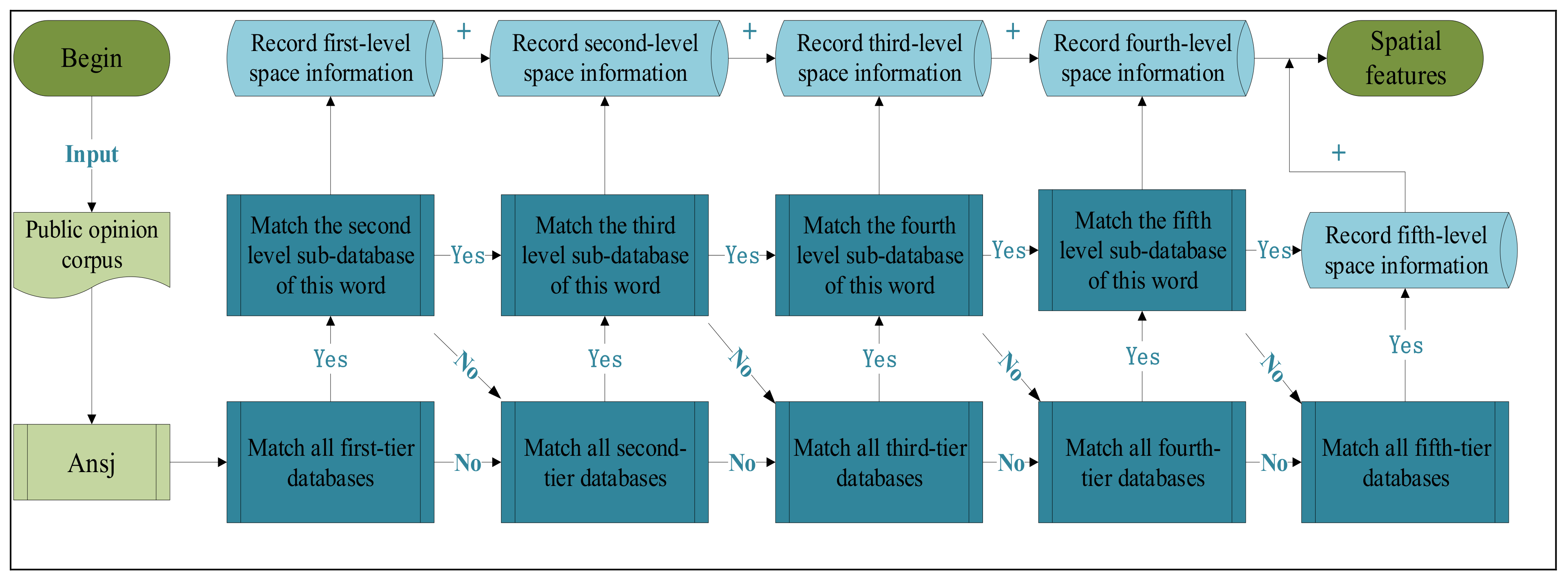
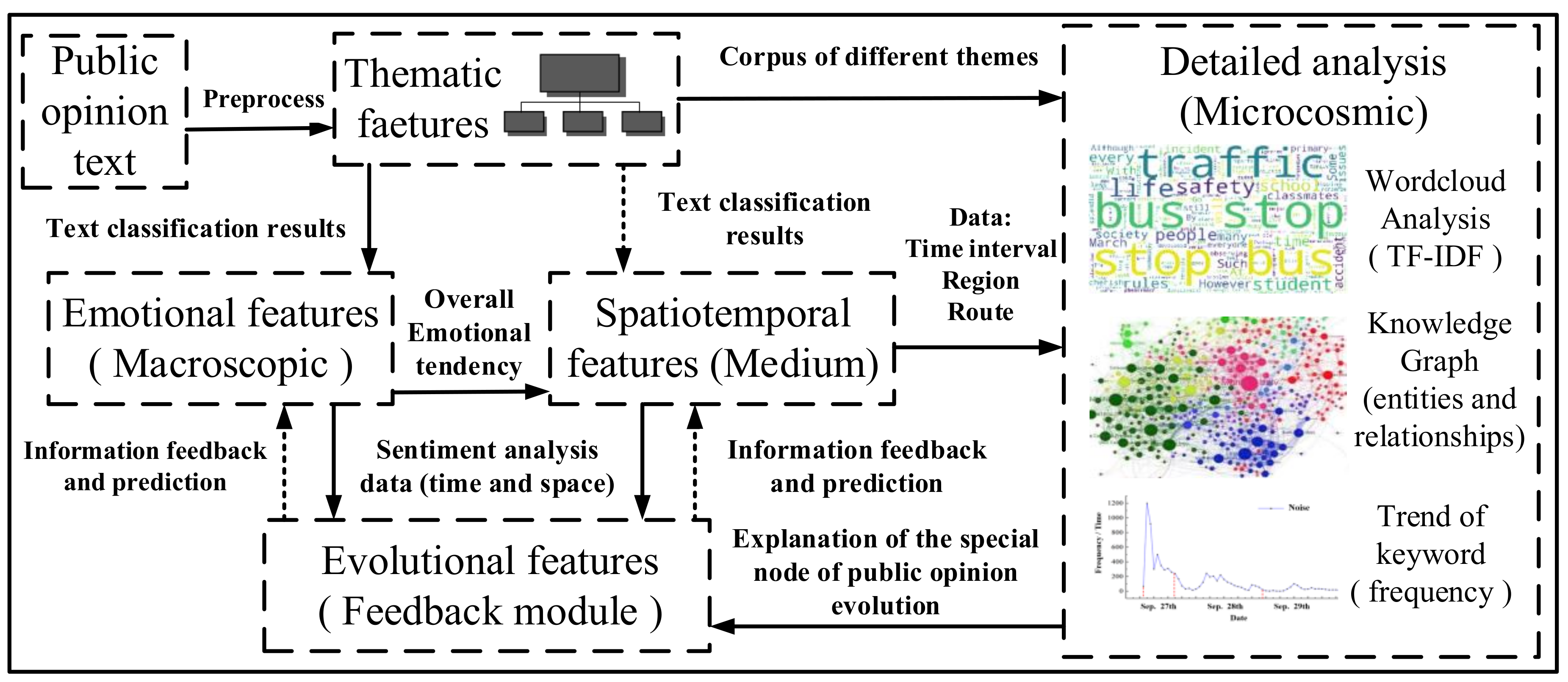


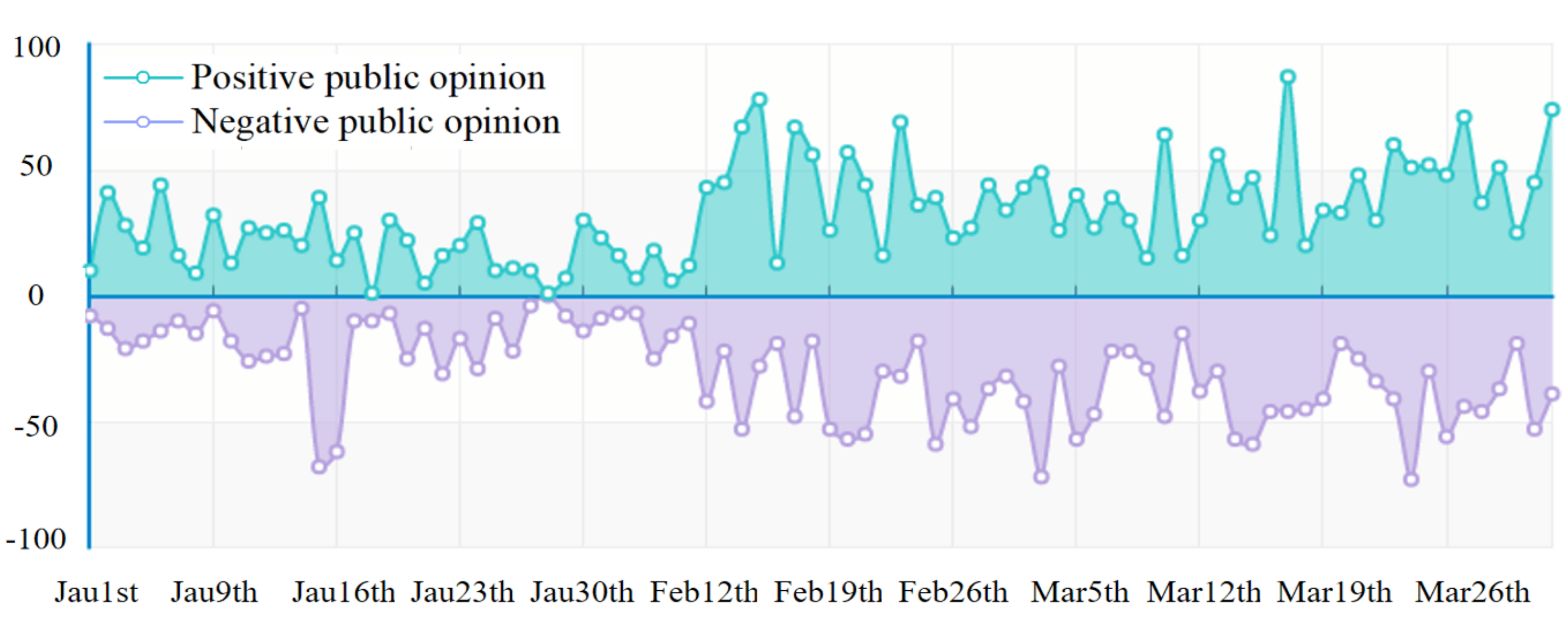
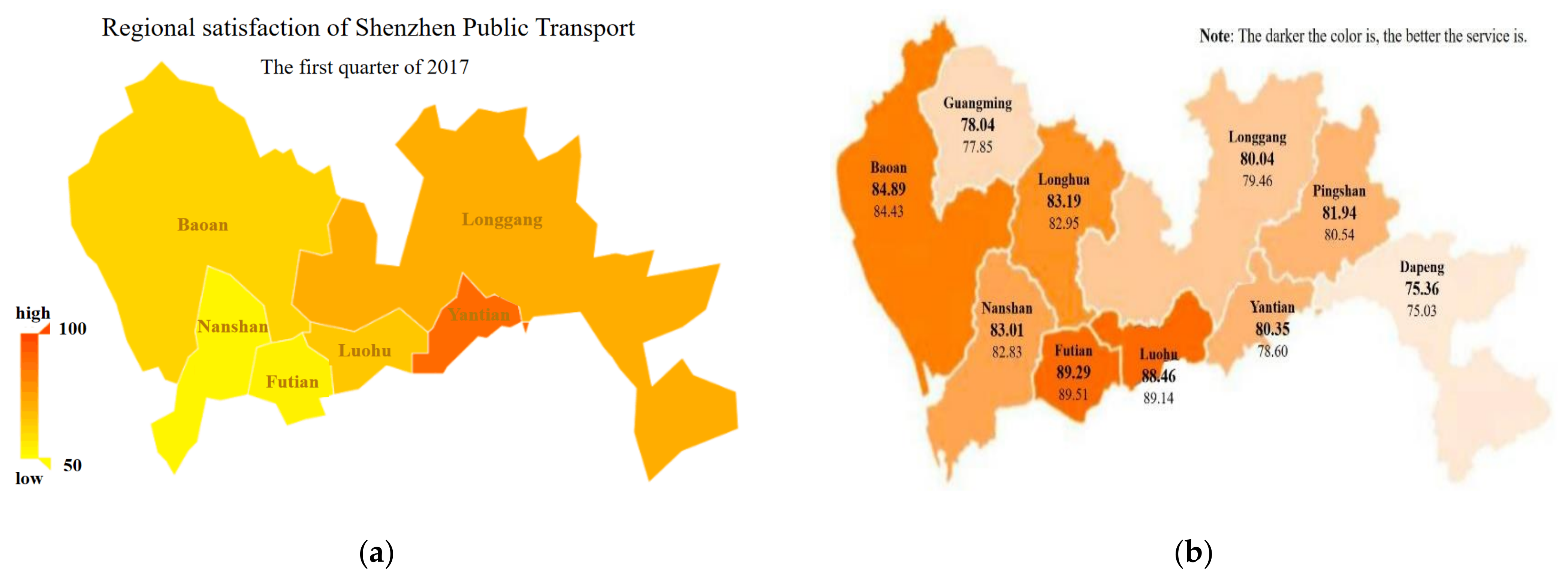
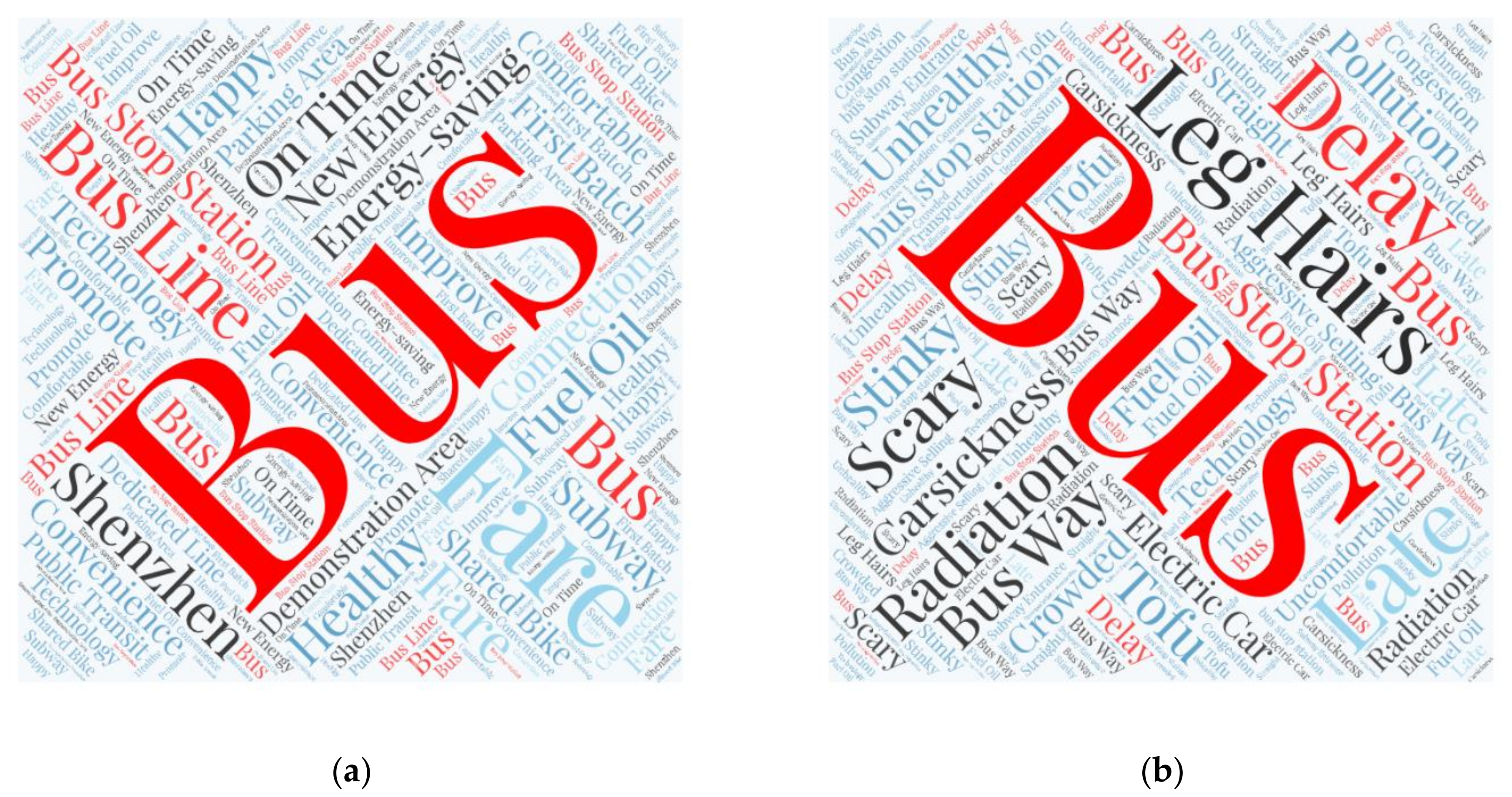
| Primary Features | Secondary Features |
|---|---|
| Thematic features [38] | Traffic accident |
| Traffic congestion | |
| Traffic control | |
| Shared transport | |
| Spatiotemporal features [39] | Time features (year, month, day, hour, minute, second) |
| Spatial features (province, city, district, road name, specific location) | |
| Emotional features [40] | Positive |
| Neutral | |
| Negative | |
| Evolutional features | Quantity of information |
| Rate of change |
| Expression Pattern | Meaning | Examples |
|---|---|---|
| Num + N | Numeral + Noun of time denoting time | 6 Dian (o’clock), 6 Yue (June) |
| N | Noun of time | Morning, Monday, Today, o’clock |
| Num: Num | Numeral: Numeral | 18:30 |
| Num. Num | Numeral. Numeral | 2020.6 |
| Num/ Num | Numeral/ Numeral | 2020/8 |
| Patterns | Collocation | Examples |
|---|---|---|
| S | Sentimental words | Happy |
| DS | Sentimental words + adverbs of degree | Convenient much more (Much more convenient) |
| Adverbs of degree + sentimental words | Very happy | |
| NS | Negative words + sentimental words | Not satisfied (Dissatisfied) |
| DNS | Adverbs of degree + negative words + sentimental words | Very not unobstructed (The traffic is very heavy) |
| NDS | Negative words + adverbs of degree+ sentimental words | Not very smooth (It is not very smooth) |
| Adverbs of Degree | Weight | Brief Introduction |
|---|---|---|
| extreme/most | 2.5 | The word strongly enhances the tone |
| very | 2.1 | Not very smooth (It is not very smooth) |
| more | 1.8 | The word enhances the tone to a certain extent |
| -ish | 1.2 | |
| insufficiently | 0.5 | The word weakens the tone |
| over | −1 | The word changes word polarity |
| Date | Number of Raw Data Crawled/pcs | Rest of Data Preprocessed/pcs | Quantity of Data after Cleaning/pcs |
|---|---|---|---|
| March 2017 | 1806 | 1606 | 1445 |
| February 2017 | 1072 | 872 | 767 |
| January 2017 | 864 | 664 | 610 |
| The fourth quarter of 2016 | 1928 | 1528 | 1390 |
| The third quarter of 2016 | 2094 | 1894 | 1665 |
| The second quarter of 2016 | 2008 | 1608 | 1436 |
| The first quarter of 2016 | 1953 | 1653 | 1464 |
Publisher’s Note: MDPI stays neutral with regard to jurisdictional claims in published maps and institutional affiliations. |
© 2020 by the authors. Licensee MDPI, Basel, Switzerland. This article is an open access article distributed under the terms and conditions of the Creative Commons Attribution (CC BY) license (http://creativecommons.org/licenses/by/4.0/).
Share and Cite
Liu, S.; Teng, J.; Gong, Y. Extraction Method and Integration Framework for Perception Features of Public Opinion in Transportation. Sustainability 2021, 13, 254. https://doi.org/10.3390/su13010254
Liu S, Teng J, Gong Y. Extraction Method and Integration Framework for Perception Features of Public Opinion in Transportation. Sustainability. 2021; 13(1):254. https://doi.org/10.3390/su13010254
Chicago/Turabian StyleLiu, Shaojie, Jing Teng, and Yue Gong. 2021. "Extraction Method and Integration Framework for Perception Features of Public Opinion in Transportation" Sustainability 13, no. 1: 254. https://doi.org/10.3390/su13010254
APA StyleLiu, S., Teng, J., & Gong, Y. (2021). Extraction Method and Integration Framework for Perception Features of Public Opinion in Transportation. Sustainability, 13(1), 254. https://doi.org/10.3390/su13010254







